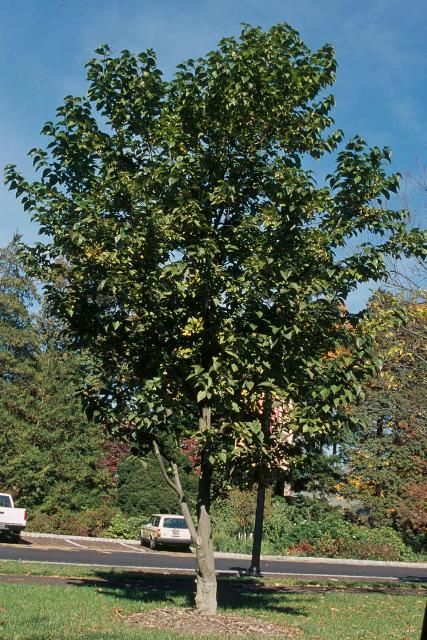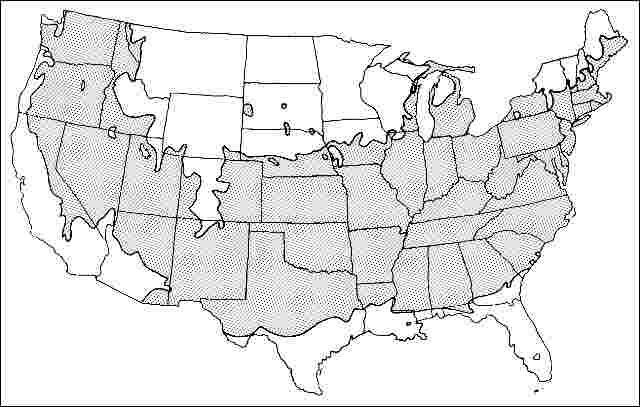Introduction
Japanese Snowbell is a small deciduous tree that slowly grows from 20 to 30 feet in height and has rounded canopy with a horizontal branching pattern. With lower branches removed, it forms a more vase-shaped patio-sized shade tree. The smooth, attractive bark has orange-brown interlacing fissures adding winter interest to any landscape. The white, bell-shaped, drooping flower clusters of Japanese Snowbell are quite showy in May to June.

Credit: Ed Gilman, UF/IFAS
General Information
Scientific name: Styrax japonicus
Pronunciation: STY-racks juh-PAWN-ih-kuss
Common name(s): 'Emerald Pagoda' Japanese Snowbell
Family: Styracaceae
USDA hardiness zones: 6A through 8A (Figure 2)
Origin: not native to North America
Invasive potential: not assessed/incomplete assessment
Uses: trained as a standard; parking lot island < 100 sq ft; parking lot island 100–200 sq ft; parking lot island > 200 sq ft; tree lawn 3–4 feet wide; tree lawn 4–6 feet wide; tree lawn > 6 ft wide; specimen; street without sidewalk; deck or patio; container or planter; sidewalk cutout (tree pit); highway median

Description
Height: 20 to 30 feet
Spread: 15 to 25 feet
Crown uniformity: symmetrical
Crown shape: round, vase
Crown density: moderate
Growth rate: slow
Texture: medium
Foliage
Leaf arrangement: alternate (Figure 3)
Leaf type: simple
Leaf margin: sinuate/undulate, entire, serrate
Leaf shape: oblong, elliptic (oval)
Leaf venation: pinnate, brachidodrome
Leaf type and persistence: deciduous
Leaf blade length: less than 2 inches, 2 to 4 inches
Leaf color: green
Fall color: yellow, red
Fall characteristic: not showy

Flower
Flower color: pink
Flower characteristics: showy
Fruit
Fruit shape: oval, round
Fruit length: less than 0.5 inch, 0.5 to 1 inch
Fruit covering: fleshy
Fruit color: green
Fruit characteristics: does not attract wildlife; not showy; fruit/leaves not a litter problem
Trunk and Branches
Trunk/bark/branches: branches droop; showy; typically multi-trunked; thorns
Pruning requirement: little required
Breakage: resistant
Current year twig color: green
Current year twig thickness: thin
Wood specific gravity: unknown
Culture
Light requirement: full sun, partial sun or partial shade
Soil tolerances: clay; sand; loam; acidic; slightly alkaline; well-drained
Drought tolerance: moderate
Aerosol salt tolerance: moderate
Other
Roots: not a problem
Winter interest: yes
Outstanding tree: yes
Ozone sensitivity: unknown
Verticillium wilt susceptibility: unknown
Pest resistance: free of serious pests and diseases
Use and Management
Styrax species is an excellent small patio tree where the flowers and interesting bark can be viewed up close; however, the flowers attract tremendous numbers of bees and one should be cautious about approaching the plant at that time. Japanese Snowbell also makes a wonderful addition to the mixed shrubbery border. Due to its small stature and vase-shape, it can make a nice street tree where overhead space is limited. The fruit is somewhat showy and may cause a small litter problem for a short time in the fall. Fall leaf color is unreliable.
Snowbell prefers a peaty, acid soil that is moist but not waterlogged. In colder areas (USDA hardiness zone 5), locate this tree in an area protected from winter winds. Plants grow better with a couple hours of shade in USDA hardiness zones 7 and 8 but full sun is fine in the North.
Cultivars include: 'Carillon' is hardy only to zone 6, grows about one-foot per year and has a weeping habit, can be staked to encourage weeping habit; 'Crystal'—upright to fastigiate habit, black green foliage, crisp white flowers with purple pedicels (zone 5); 'Issai'—cold hardy to zone 6, grows faster than other species and roots easily; 'Pink Chimes'—pink flowers, cold hardy to zone 6.
Propagate by softwood cuttings in summer. Seeds eventually germinate but exhibit a double dormancy.
Pests and Diseases
No pests or diseases of major concern. Ambrosia beetle can attack and lead to further decline of stressed plants.